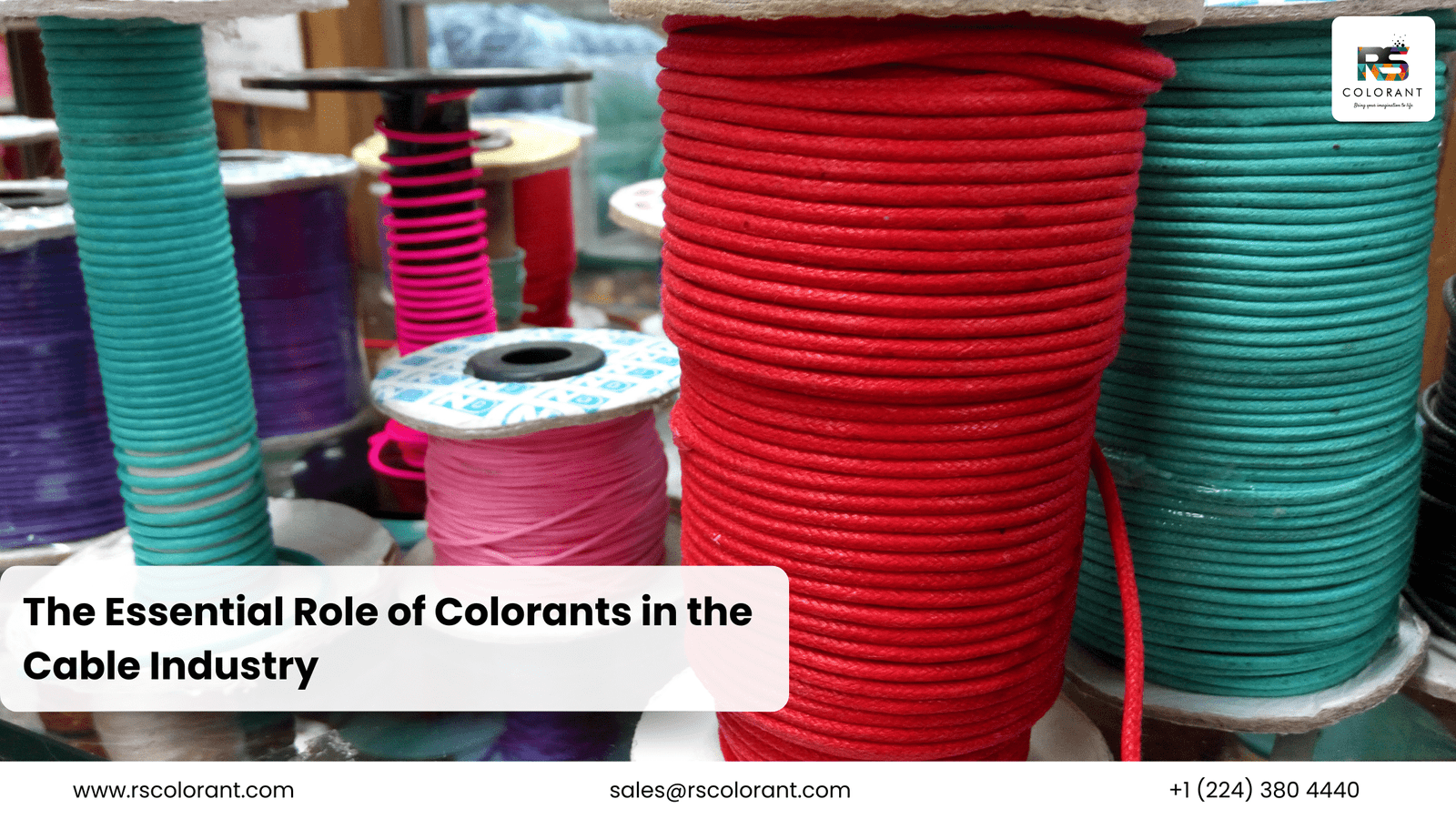Colorants in the Cable Industry – Introduction
In the sprawling and intricate world of the cable industry, colorants play a surprisingly pivotal role. These unsung heroes not only enhance the visual appeal of cables but also serve crucial functional purposes, ensuring that our interconnected world runs smoothly and efficiently. Let’s dive into the vibrant world of cable colorants and understand their significance.
Understanding Colorants
Definition and Types of Colorants
Colorants are substances that impart color to a material. They can be categorized into dyes and pigments. Dyes are soluble and tend to permeate the material, while pigments are insoluble and rest on the surface. Both types are essential in various applications within the cable industry.
Historical Perspective on the Use of Colorants
The use of colorants dates back to ancient civilizations, where natural dyes were extracted from plants and minerals. The cable industry adopted these practices in the mid-20th century, evolving from simple identification techniques to complex, standardized color coding systems.
Types of Colorants Used in Cables
Organic Colorants
Organic colorants, derived from carbon-based molecules, offer a broad spectrum of vibrant colors. They are often used in applications requiring high visibility and aesthetic appeal.
Inorganic Colorants
Inorganic colorants, composed of mineral compounds, are valued for their stability and durability. These are typically used in environments where cables are exposed to harsh conditions.
Natural vs. Synthetic Colorants
While natural colorants are eco-friendly, synthetic colorants dominate the industry due to their consistency, availability, and cost-effectiveness. However, there is a growing interest in sustainable alternatives.
Functions of Colorants in Cables
Identification and Differentiation
One of the primary functions of colorants is to facilitate the identification and differentiation of cables. Color-coded cables help technicians and engineers quickly identify specific functions and connections, reducing the risk of errors.
Aesthetic Purposes
In environments where cables are visible, such as in homes or commercial spaces, colorants enhance the aesthetic appeal. This not only improves the visual harmony of the space but also aligns with brand identities.
Functional Benefits
Colorants can also impart functional benefits, such as UV resistance, fire retardancy, and improved durability. These properties are critical in ensuring the long-term performance and safety of cables.
Manufacturing Process
Incorporation of Colorants into Cable Materials
Colorants are typically incorporated into cable materials during the manufacturing process. This can be done through masterbatching, where concentrated colorant pellets are mixed with the base material, or through surface coating techniques.
Techniques Used in Coloring Cables
Extrusion is a common technique used to color cables, where the colorant is mixed with the base polymer and extruded into the desired shape. Another method is co-extrusion, which allows for multiple layers of colorants, providing enhanced performance characteristics.
Materials Used in Cable Coloration
Common Materials That Are Colored
PVC (polyvinyl chloride), PE (polyethylene), and PP (polypropylene) are among the most common materials used in cable insulation and sheathing that are colored using various colorants.
Special Materials and Their Coloration Needs
Specialty cables made from materials like Teflon or silicone require specific types of colorants that can withstand high temperatures and other demanding conditions.
Color Coding Systems
International Standards and Practices
Color coding systems are standardized across different regions and industries to ensure consistency and safety. For example, the IEC (International Electrotechnical Commission) and NEC (National Electrical Code) provide guidelines for color coding in electrical installations.
Industry-Specific Color Coding
Different industries have specific color coding requirements. For instance, the telecommunications industry uses a unique set of color codes to differentiate between various types of cables and their functions.
Regulatory Considerations
Environmental Regulations
Regulatory bodies impose strict guidelines on the use of colorants, especially regarding their environmental impact. Manufacturers must comply with regulations such as RoHS (Restriction of Hazardous Substances) and REACH (Registration, Evaluation, Authorisation, and Restriction of Chemicals).
Health and Safety Standards
The safety of workers handling colorants and the end-users of colored cables is paramount. Safety data sheets (SDS) and proper handling procedures are mandatory to ensure compliance with health and safety standards.
Challenges in Using Colorants
Technical Challenges
Incorporating colorants without compromising the mechanical and electrical properties of cables is a significant technical challenge. Ensuring uniformity and stability of color over time and in varying conditions is another hurdle.
Economic Considerations
Cost is a critical factor in the selection of colorants. High-quality, durable colorants can be expensive, and manufacturers must balance performance with cost-effectiveness.
Environmental Impact
The production and disposal of colorants can have environmental repercussions. The industry is increasingly focused on developing eco-friendly colorants to mitigate these impacts.
Innovations in Cable Coloration
Advances in Colorant Technology
Recent advancements have led to the development of high-performance colorants that offer superior resistance to UV light, heat, and chemicals. These innovations extend the lifespan and reliability of cables.
Sustainable and Eco-Friendly Colorants
There is a growing trend towards sustainable colorants made from natural or recycled materials. These eco-friendly alternatives reduce the environmental footprint of cable production.
Case Studies
Successful Implementations of Colorants in Cables
Several companies have successfully implemented advanced colorants in their cable products. For example, a leading telecommunications company introduced a new range of cables with enhanced UV resistance, resulting in improved performance and customer satisfaction.
Lessons Learned from Industry Applications
Case studies reveal that collaboration between colorant manufacturers and cable producers is essential for successful implementation. Ongoing research and development play a crucial role in overcoming challenges and optimizing colorant performance.
The Future of Colorants in the Cable Industry
Trends and Predictions
The future of colorants in the cable industry looks promising, with continued advancements in technology and a growing emphasis on sustainability. Innovations in nanotechnology and smart colorants that change color in response to environmental conditions are on the horizon.
Potential Impact of Emerging Technologies
Emerging technologies, such as 3D printing and advanced manufacturing processes, are set to revolutionize the way colorants are used in cables. These technologies offer new possibilities for customization and performance enhancement.
Environmental Impact
Lifecycle Analysis of Colorants
A comprehensive lifecycle analysis of colorants helps in understanding their environmental impact from production to disposal. This analysis is critical for developing strategies to minimize the ecological footprint of cable production.
Efforts to Reduce Ecological Footprint
The cable industry is actively exploring ways to reduce its ecological footprint. This includes using biodegradable colorants, recycling cable materials, and adopting more efficient manufacturing processes.
Consumer Perspective
Importance of Color in Consumer Choices
For consumers, color plays a significant role in their purchasing decisions. Whether it’s choosing the right cables for a home entertainment system or selecting industrial cables, colorants help simplify choices and ensure compatibility.
Colorants in Home and Industrial Applications
In home applications, color-coded cables help in organizing and managing electronic devices. In industrial settings, colorants are crucial for safety, efficiency, and compliance with regulatory standards.
Conclusion
Colorants are indispensable in the cable industry, serving both functional and aesthetic purposes. As technology advances and environmental considerations become more critical, the role of colorants will continue to evolve. The future holds exciting possibilities, from sustainable colorants to innovative applications that enhance cable performance and reduce environmental impact.
FAQs
- Why are colorants used in cables? Colorants are used in cables primarily for identification and differentiation, aesthetic purposes, and to impart specific functional benefits such as UV resistance and fire retardancy.
- What types of colorants are used in the cable industry? The cable industry uses organic and inorganic colorants, with both natural and synthetic options available depending on the application requirements.
- How do colorants impact the performance of cables? Colorants can enhance the performance of cables by providing additional properties such as UV resistance, increased durability, and better visibility for identification.
- Are there environmental concerns associated with cable colorants? Yes, there are environmental concerns related to the production and disposal of colorants. The industry is moving towards more sustainable and eco-friendly colorant options to mitigate these impacts.
- What are the future trends in cable colorants? Future trends in cable colorants include the development of high-performance, sustainable colorants, and the integration of emerging technologies like 3D printing and smart colorants that adapt to environmental conditions.




